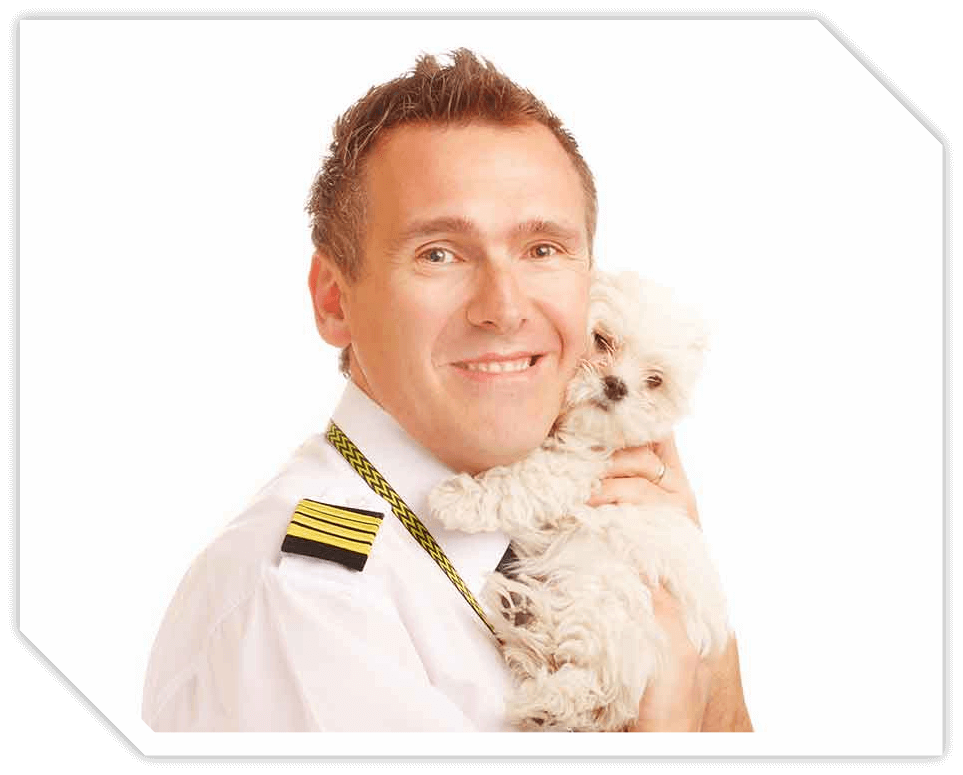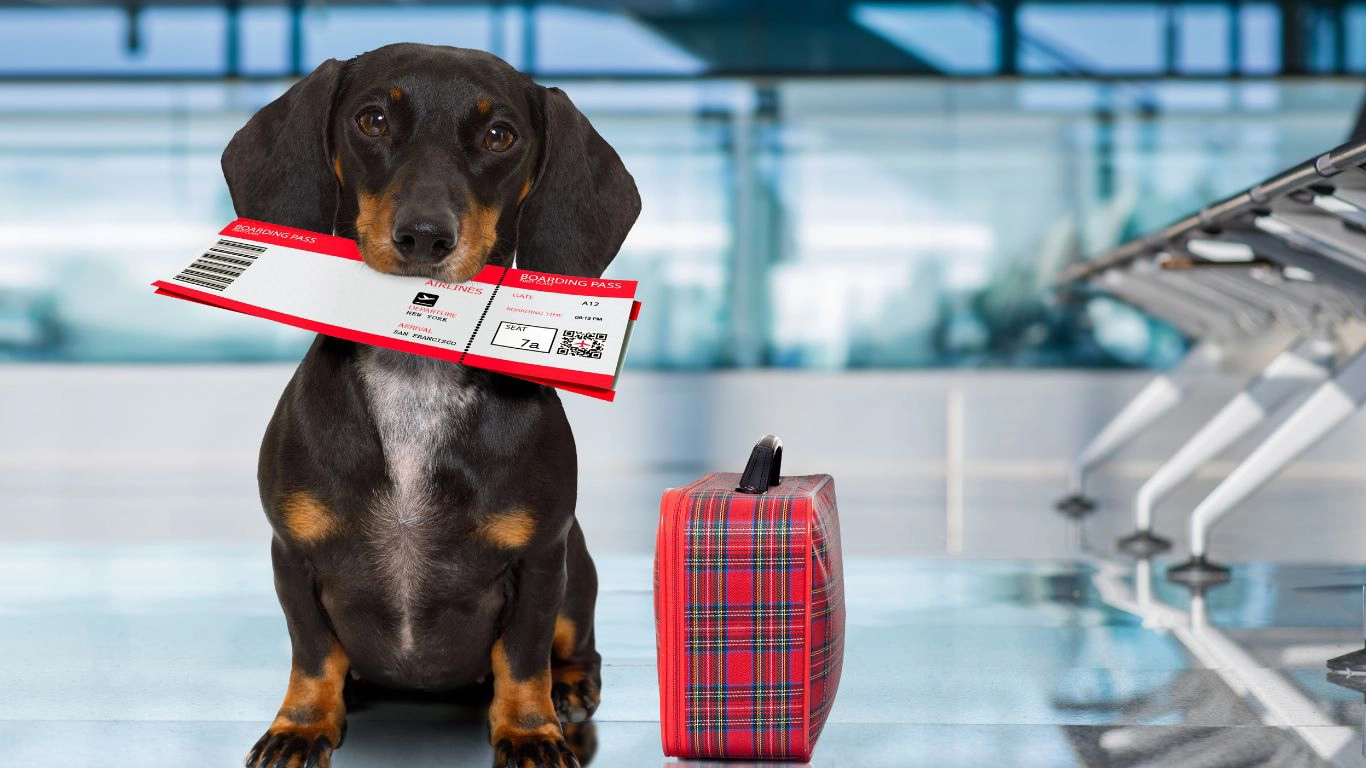Is travel by air the right choice for your pet?
The answer is YES if your pet is:
- Comfortable with new places and experiences.
- Gets along well with strangers and other pets.
- A cat or small dog can fit in a carrier below the seat in front of you. Most airlines allow dogs up to 20 lbs., but always call ahead to check.
- Is a dog weighing over 20 lbs. and is comfortable being left alone for many hours.
The answer is most likely NO if your pet is:
- Is a brachycephalic or snub-nosed breed like a Persian, Pug or Pekingese
- Is prone to anxiety or claustrophobia, so may not do well on flights or may need medication to relax for the duration.
- Is a dog weighing over 70 lbs. — some airlines have caps on weight, even for pets who fly as cargo.
- Is from 20–70 lbs. but suffers from separation anxiety or doesn’t like being left alone for long periods of time.
Note: Air travel for these pets should only be undertaken with much consideration or, if necessary, such as a family move. Ask us about both short-term and long-term- for your pet.
Check your pet’s physical and mental health before a flight
- Ask your veterinarian if your dog is physically fit to fly. Overweight dogs, smoosh-faced breeds, and pets with certain health conditions can experience in-flight complications.
- Ask how you can keep your pet calm for the flight. Dogs and cats are prone to stress, fear, aggression, separation anxiety, or claustrophobia and can experience a turbulent time in the sky. Your veterinarian may recommend holistic remedies, physical aides (like a Thundershirt® or Mutt Muffs) or even an anti-anxiety medication to keep your pup feeling fine.
- Take a copy of your pet’s health records with you.
- Ensure your pet is current on all heart worm prevention and vaccines. Different states and countries have different vaccination requirements, so do your research before you go. Visit the U.S. Department of Agriculture’s website for stateside requirements.
- Make sure your pet is micro chipped. Some countries won’t let your pet in without one
- Stock up on prescription meds — it could be hard to find refills once you reach your destination.
Health Certificates for US travel
Get your pet’s travel documents in order, including Health Certificates and any other documents required by your airline that may be required. Note: Within the US, generally, Health Certificates must be signed and dated within 30 days of your departure.
Health Certificates for International Travel
Many countries, including those in the European Union, have their own specific health certificates, but some countries do not. If that’s the case, you should use a U.S. Interstate and International Certificate of Health Examination for Small Animals, which you can download here. Your veterinarian must issue this within 21 days of departure.
Rabies – International Travel
There are three rabies classifications for nations:
Rabies-free countries:
These countries have no incidence of rabies. If you’re traveling to one of these countries from a place with a higher incidence of rabies, your pet will likely require a blood titer test, a microchip and a pet passport and be subject to a quarantine period when he arrives. Countries Include:
- UK
- Australia
- Guam
- Iceland
- Japan
- Singapore
- Tahiti
- Antigua
- Turks & Caicos
Low incidence:
These countries have a low, but not non-existent, incidence of rabies. Pets traveling to these countries generally need blood titer tests and microchips and may require a quarantine period when entering. Countries Include:
- United States
- most of the EU
- Canada
- Russia
- Taiwan
- United Arab Emirates
high incidence of rabies countries:
Most of these countries require only a pet passport and sometimes an import permit. They tend not to require a blood titer or microchip. However, if you travel from these countries to a nation with a lower incidence of rabies, your pet is likely to be subjected to blood titer tests and quarantine upon arrival. Countries Include:
- Bahamas
- China
- Costa Rica
- India
- most (but not all) countries in the Middle East
- most (but not all) countries in Southeast Asia
Airlines that roll out the RED CARPET for pet

- Alaska Air has a Fur-st Class™ care policy and PetStreak™ Animal Express experts trained to take care of furry fliers.
- JetBlue’s PetPaws program includes a special tag for your carrier, a handy Petiquette guide and extra TrueBlue points for flying with a dog or cat.
- Frontier Airlines allows up to 10 small dogs in the cabin – great if your kennel club wants to travel together!
- Delta’s Pet First service allows you to ship pets in the cabin, in cargo or as baggage, although size restrictions apply.
- Southwest has its own branded carry-on kennels, which you can purchase for a nominal fee before your flight
- Air Canada has professionally trained animal specialists aboard select flights
- KLM lets small dogs and cats fly in the economy cabin on international flights and even extends the invitation to business class for flights within Europe
- Lufthansa allows small dogs and cats in the cabin; for larger canines, there’s a special, air-conditioned section of the cargo hold
Major airlines’ pet policies
Here are several links to major airlines that list their pet travel policies.
- Delta Air Lines: Delta Pet Policy and Other Information
- American Airlines: American Airlines Pet Travel Information and Policies
- United Airlines: United Airlines Travel for Pets Information
- JetBlue Airways: JetPaws Program
- Southwest Airlines: Southwest Pet Policy and Pet Reservations
- Spirit Airlines: Spirit Rules for Pets Onboard
If your pet must fly in the cargo area, here are some tips:
- Choose a direct flight; they’re shorter and generally less stressful to pets
- Make sure cargo areas are climate and pressure-controlled before you book your flight so you can relax, knowing your furry friend is comfortable.
- Avoid flying in mid-summer or winter when temperatures are most extreme — especially if the cargo area is not climate-controlled, this can be dangerous for pets.
- Offer your pet water and a snack before you fly, but not a full meal (it could make him uncomfortable during the flight if he has to hold it).
- Pack a blanket or towel that smells like home and a favorite toy in your pet’s crate so he doesn’t get bored.
- Ask to watch your pet being boarded onto the plane for your own peace of mind.
- Ask your flight attendant to inform the captain that there is an animal in the cargo hold so that he can adjust the temperature and pressure there accordingly.
WOOF! Until next time.



